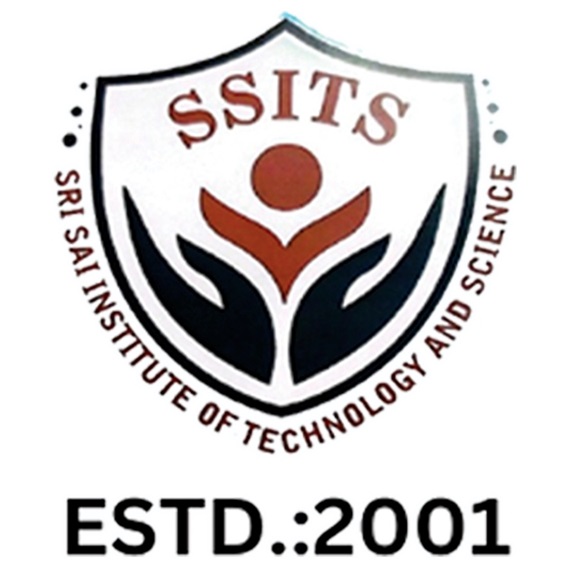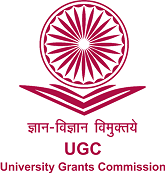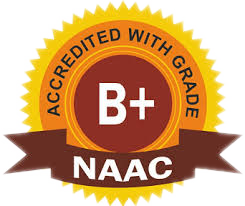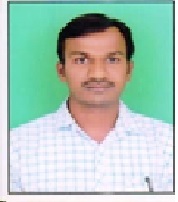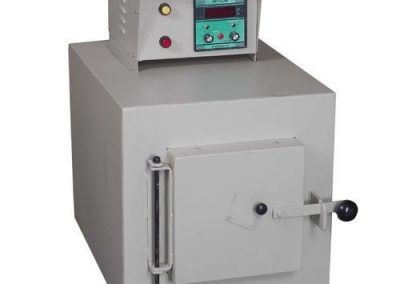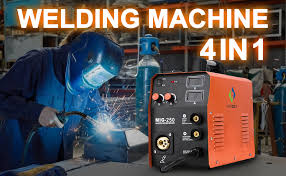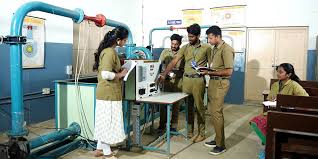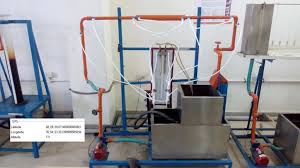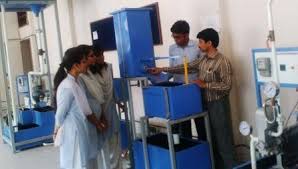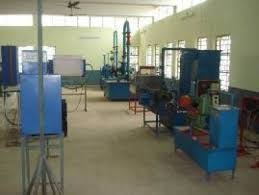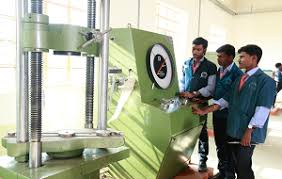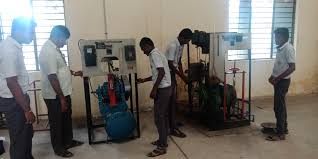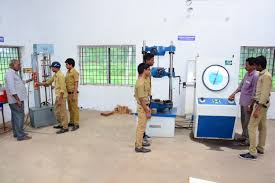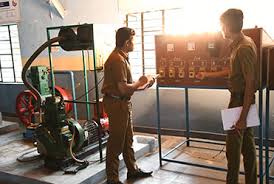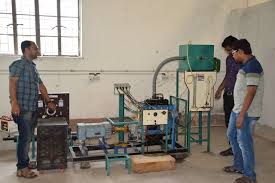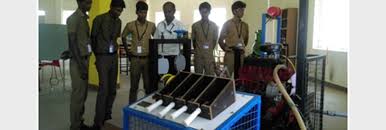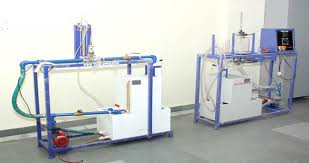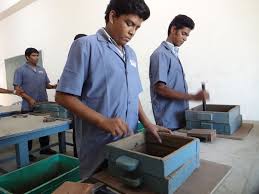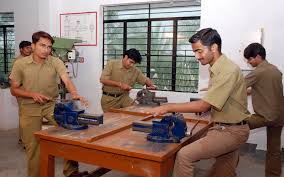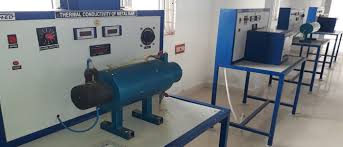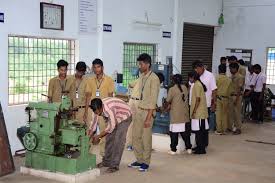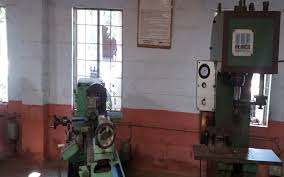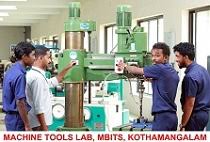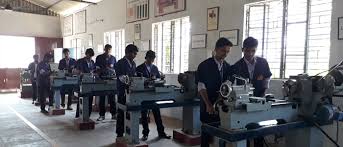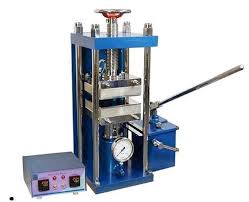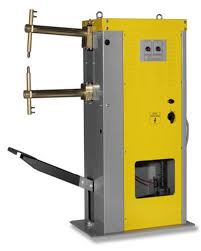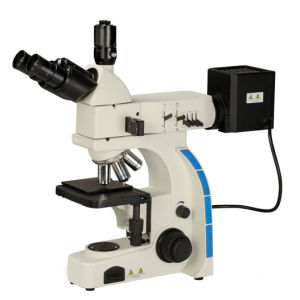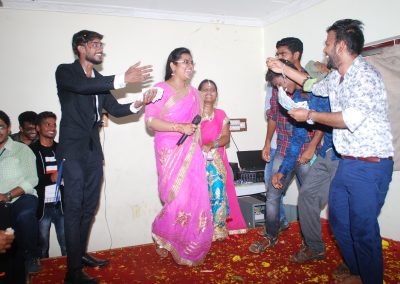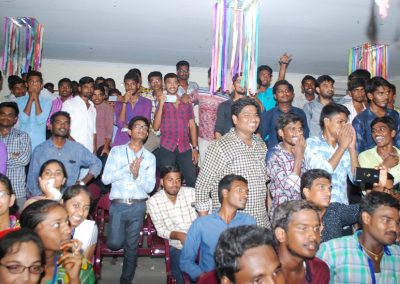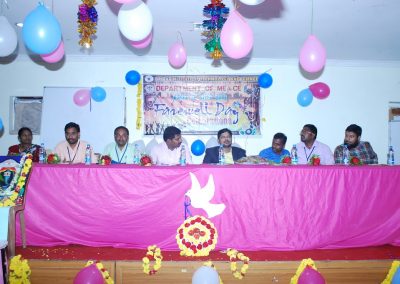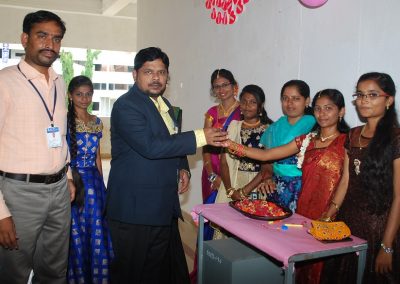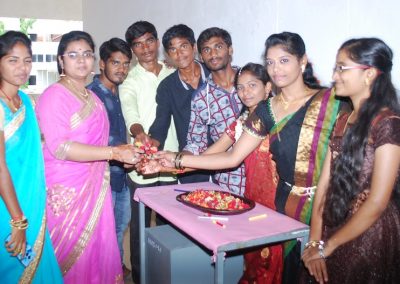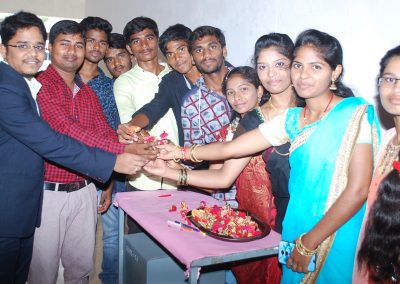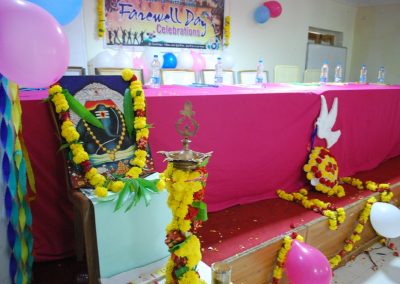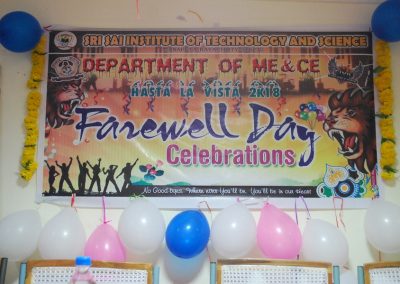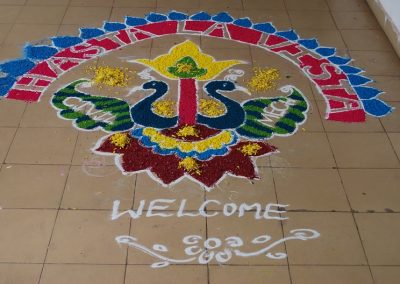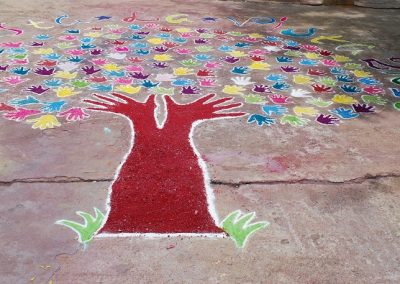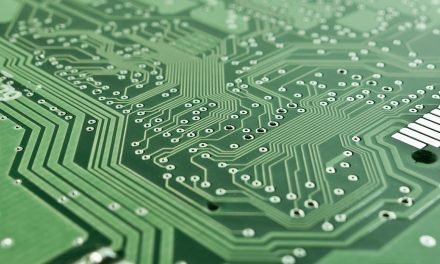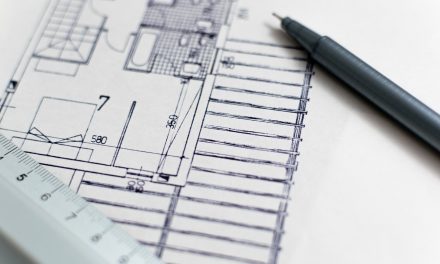Dept. of Mechanical Engineering
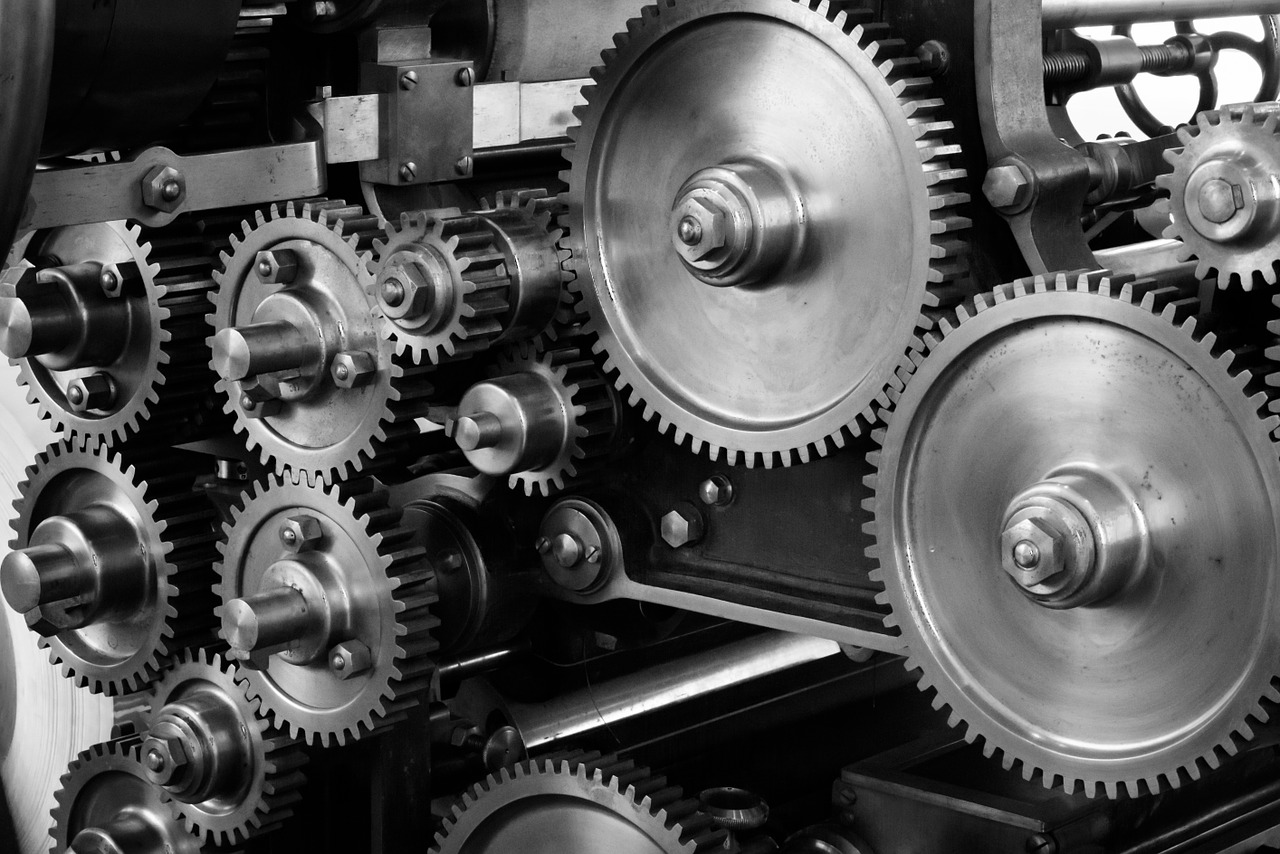
Dept. of Mechanical Engineering
About Department of Mechanical Engineering:
The dept. of Mechanical Engineering (ME) was established in the year 2011 and present with an intake of 30 seats.
Aim
The aim of the mechanical department to give graduates the necessary skills but also to shape the thinking and team-working spirit to ensure the best prospects for successful careers and / or further study within the heavy demands of modern times.
Vision:
To become a center of excellence in the field of mechanical engineering by producing graduates
with technical knowledge, research, consultancy, entrepreneurial skills, along with leadership
qualities and ethics, and to cater to the needs of society.
Mission
To impart quality education and training to nurture globally competitive mechanical engineers
by effective teaching-learning practices and state-of-the-art laboratories through eminent faculty.
To establish linkages with industries and research organizations to bring excellence in problem-solving skills, research, and consultancy services.
Scope
To acquire the knowledge, Department develops suitable theoretical background studies with state of art laboratory and hand on skills training, and department infrastructure for applied technology research. By obtaining theoretical and applied scientific training, our graduates are equipped with the necessary knowledge and skills to meet the particularly demanding market in the best possible way.
Program Specific Outcomes (PSO’s)
Mechanical graduates to gain knowledge on core engineering concepts, emerging fields, entrepreneur skills, and sustainable environmental engineering.
Able to work as an individual or team with strong leadership qualities, ethics, and moral values.
Able to work in multidisciplinary fields.
Program Educational Objectives (PEO’s)
To apply knowledge of engineering, mathematics, and science in the field of core engineering solutions for complex problems.
Analyze the issues related to mechanical engineering and find the optimized designs, drawings, and crafting with environmental conciseness.
Design and develop the prototypes; case studies in the field of mechanical engineering.
PROGRAMME OUTCOMES (POs)
PO1: Engineering Knowledge: Apply the knowledge of Mathematics, Science, Engineering fundamentals, and an Engineering specialization to the solution of complex Engineering problems.
PO2: Problem Analysis: Identify, formulate, review research literature, and analyze complex Engineering problems reaching substantiated conclusions using first principles of Mathematics, Natural Sciences, and Engineering Sciences.
PO3: Design/ Development of Solutions: Design solutions for complex Engineering problems and design system components or processes that meet the specified needs with appropriate consideration for the public health and safety, and the cultural, societal, and environmental considerations.
PO4: Conduct investigations of complex problems: Use research-based knowledge and research methods including design of experiments, analysis and interpretation of data, and synthesis of the information to provide valid conclusions.
PO5: Modern Tool Usage: Create, select, and apply appropriate techniques, resources, and modern Engineering and IT tools including prediction and modeling to complex Engineering activities with an understanding of the limitations.
PO6: The Engineer and Society: Apply reasoning informed by the contextual knowledge to assess societal, health, safety, legal and cultural issues and the consequent responsibilities relevant to the professional Engineering practice.
PO7: Environment and Sustainability: Understand the impact of the professional Engineering solutions in societal and environmental contexts, and demonstrate the knowledge of, and need for sustainable development.
PO8: Ethics: Apply ethical principles and commit to professional ethics and responsibilities and norms of the Engineering practice.
PO9: Individual and Team Work: Function effectively as an individual, and as a member or leader in diverse teams, and in multidisciplinary settings.
PO10: Communication: Communicate effectively on complex Engineering activities with the Engineering community and with society at large, such as being able to comprehend and write effective reports and design documentation, make effective presentations, and give and receive clear instructions.
PO11: Project Management and Finance: Demonstrate knowledge and understanding of the Engineering and management principles and apply these to one’s own work, as a member and leader in a team, to manage projects and in multidisciplinary environments.
PO12: Life-long Learning: Recognize the need for, and have the preparation and ability to engage in independent and life-long learning in the broadest context of technological change.
Head of the Dept. The Mechanical Engineers of today are multidisciplinary, with knowledge from other branches of engineering and centre of all technical advancements. Industrial development of any country depends upon the quality of Mechanical Engineers that are being produced; and the economical status of the country depends on the quantum of industrial development. With 11 years of sound standing, Sri Sai Institute of Technology & Science, Rayachoty, YSR Dist., is in a better to established Mechanical Engineering branch, meeting the huge budget requirements. We are confident of producing meritorious Mechanical Engineers to meet the ever increasing industrial needs. The department labs are well equipped to meet the requirements of JNT University. Additionally, the department possesses very good infrastructure in the form of sophisticated staffrooms, department library, well furnished drawing halls, seminar hall, classrooms with modern teaching aids and CC cameras to monitor the performance of the staff and the students.PALLAM SRAVAN KUMAR
M. Tech
Faculty List:
|
S.NO |
NAME OF THE FACULTY |
DATE OF JOINING |
DESIGNATION |
QUALIFICATION |
|
1. |
Dr .V. BALAJI |
13-07-2019 |
Professor & Principal |
Ph.D |
|
2. |
P.SRAVANKUMAR |
01-07-2013 |
Asst. Professor |
M. Tech |
|
3. |
S.NASAR |
13-12-2018 |
Asst. Professor |
M. Tech |
|
4 |
D.R.SUBBA RAO |
23-12-2021 |
Asst. Professor |
M. Tech |
|
5 |
V.ESWARAIAH |
03-01-2025 |
Asst. Professor |
M. Tech |
The department labs are well equipped to meet the requirements of JNTUniversity. Additionally the department possesses very good infrastructure in the form of sophisticated staffrooms, department library, well furnished drawing halls, seminar hall, classrooms with modern teaching aids and CCTV cameras to monitor the performance of the staff and the students.
| S.NO | NAME OF THE LABORATORY | EQUIPMENT | QTY | COST |
| 1 | ENGG.WORKSHOP | BENCH VICES | 8 | 10320/-RS |
| 2 | ENGG.WORKSHOP | CARPENTRY VICES | 10 | 10180 |
| 3 | ENGG.WORKSHOP | STEEL RULE | 15 | 330 |
| 4 | ENGG.WORKSHOP | TRY SQUARE | 24 | 2112 |
| 5 | ENGG.WORKSHOP | HAND SAW | 10 | 780 |
| 6 | ENGG.WORKSHOP | FIRMER CHISEL3/4’ | 10 | 280 |
| 7 | ENGG.WORKSHOP | MORTICE CHIESEL | 10 | 320 |
| 8 | ENGG.WORKSHOP | FIRMER CHISEL1/2’ | 10 | 260 |
| 9 | ENGG.WORKSHOP | WOODEN MALLET | 7 | 140 |
| 10 | ENGG.WORKSHOP | WOOD RASP | 15 | 3750 |
| 11 | ENGG.WORKSHOP | METAL JACK PLANE | 15 | 4200 |
| 12 | ENGG.WORKSHOP | MARKING GUAGE | 15 | 1290 |
| 13 | ENGG.WORKSHOP | HAW SAW FRAME12” | 8 | 440 |
| 14 | ENGG.WORKSHOP | DOT PUNCH4” | 8 | 128 |
| 15 | ENGG.WORKSHOP | BALL PEEN HAMMER | 24 | 1152 |
| 16 | ENGG.WORKSHOP | SPRING DIVIDER | 8 | 192 |
| 17 | ENGG.WORKSHOP | ODD LEG CALIPERS | 8 | 224 |
| 18 | ENGG.WORKSHOP | FLAT ROUGH FILE 12” | 8 | 1000 |
| 19 | ENGG.WORKSHOP | FLAT SMOOTH FILE 12” | 8 | 1496 |
| 20 | ENGG.WORKSHOP | HALF ROUND FILE | 8 | 1760 |
| 21 | ENGG.WORKSHOP | TRIANGULAR ROUGH FILE6” | 8 | 840 |
| 22 | ENGG.WORKSHOP | SQUARE ROUGH FILE6 | 8 | 816 |
| 23 | ENGG.WORKSHOP | ROUND ROUGH FILE6 | 8 | 768 |
| 24 | ENGG.WORKSHOP | STAKE HARCHET | 3 | 1425 |
| 25 | ENGG.WORKSHOP | STRIGHT SNIP | 10 | 1100 |
| 26 | ENGG.WORKSHOP | BENT SNIP | 15 | 2100 |
| 27 | ENGG.WORKSHOP | ANIVIL 25KG | 1 | 1555 |
| 28 | ENGG.WORKSHOP | DEVIDER | 5 | 110 |
| 29 | ENGG.WORKSHOP | FUNNEL STAKES | 30 | 20,400 |
| 30 | ENGG.WORKSHOP | RAMMERS | 8 | 520 |
| 31 | ENGG.WORKSHOP | VENT RODS | 8 | 240 |
| 32 | ENGG.WORKSHOP | DRAW SPIKES | 8 | 240 |
| 33 | ENGG.WORKSHOP | STRIKE OF BARS | 8 | 200 |
| 34 | ENGG.WORKSHOP | TRAMMERS | 8 | 480 |
| 35 | ENGG.WORKSHOP | RUNNERS | 10 | 600 |
| 36 | ENGG.WORKSHOP | RAISERS | 10 | 600 |
| 37 | ENGG.WORKSHOP | SINGLE PIECE PATTERN | 10 | 780 |
| 38 | ENGG.WORKSHOP | DPOUBLE PIECE PATTERNS | 5 | 3900 |
| II B.TECH I-SEM (R15) | ||
| COURSE & CODE | CO’S N0 | COURSE OUTCOMES |
| (15A54301) MATHEMATICS-III | CO1 | the student will able to understand various aspects of Managerial Economics |
| CO2 | analysis of financial statements and inputs therein will help them to make sound | |
| CO3 | effective decisions under different economic environment and market situations. | |
| CO4 | ||
| CO5 | ||
| COURSE & CODE | CO’S N0 | COURSE OUTCOMES |
| (19A52602b) MANAGERIAL ECONOMICS AND FINANCIAL ANALYSIS | CO1 | Understand the fundamentals of Economics viz., Demand, Production, cost, revenue and markets |
| CO2 | Apply concepts of production , cost and revenues for effective business decisions | |
| CO3 | Students can analyze how to invest their capital and maximize returns | |
| CO4 | Evaluate the capital budgeting techniques | |
| CO5 | ||
| COURSE & CODE | CO’S N0 | COURSE OUTCOMES |
| (15A01308) MECHANICS OF SOLIDS | CO1 | student how to measure the strength of materials based on calculating stresses, strains and deformations for basic geometries subjected to axial loading and thermal effects |
| CO2 | students how to draw shear force and bending moment diagrams for calculating maximum shear force and maximum bending moment . | |
| CO3 | students how to calculate the shear strength of the solid and hallow shafts which are subjected to torsional loading in power transmitting | |
| CO4 | ||
| CO5 | ||
| COURSE & CODE | CO’S N0 | COURSE OUTCOMES |
| (15A03301) ENGINEERING DRAWING FOR MECHANICAL ENGINEERS | CO1 | To enhance the student’s knowledge and skills in engineering drawing of solids with interpenetration of solids and to present isometric and perspective projections. |
| CO2 | ||
| CO3 | ||
| CO4 | ||
| CO5 | ||
| COURSE & CODE | CO’S N0 | COURSE OUTCOMES |
| (15A03302) ENGINEERING MECHANICS | CO1 | Resolve forces and couples in mechanical systems. (L3) |
| CO2 | Identify the frictional forces and its influence on equilibrium. (L3) | |
| CO3 | Find the centre of gravity and moment of inertia for various geometric shapes (L3) | |
| CO4 | Develop equations for different motions. (L4) | |
| CO5 | Determine the displacement, velocity and acceleration relations in dynamic systems (L4) | |
| Relate the impulse and momentum (L4) | ||
| COURSE & CODE | CO’S N0 | COURSE OUTCOMES |
| (15A03303) THERMODYNAMICS | CO1 | Explain the importance of thermodynamic properties related to conversion of heat energy into work. (L3) |
| CO2 | Apply the laws of thermodynamics to boilers, heat pumps, refrigerators, heat engines, compressors and nozzles. (L3) | |
| CO3 | Utilize steam properties to design steam based components. (L4) | |
| CO4 | Compare thermodynamic relations and air standard cycles. (L4) | |
| CO5 | ||
| COURSE & CODE | CO’S N0 | COURSE OUTCOMES |
| (15A01309) MECHANICS OF SOLIDS LABORATORY | CO1 | Apply the concepts of stress and strain to machine numbers. (L3) |
| CO2 | Determine, shear forces, and bending moments in beams. (L4) | |
| CO3 | Find the slope and deflection in beams.(L4) | |
| CO4 | Estimate the stress in machine members such as shafts and springs.(L4) | |
| CO5 | Apply Castigliano’s theorem to determine displacements in beams. (L3) | |
| Analyse columns for buckling loads.(L4) | ||
| COURSE & CODE | CO’S N0 | COURSE OUTCOMES |
| (15A03304) COMPUTER AIDED DRAFTING LAB | CO1 | Demonstrate the conventional representations of materials and machine components. |
| CO2 | Model riveted, welded and key joints using CAD system. | |
| CO3 | Create solid models and sectional views of machine components | |
| CO4 | Generate solid models of machine parts and assemble them. | |
| CO5 | Translate 3D assemblies into 2D drawings. | |
| Create manufacturing drawing with dimensional and geometric tolerances | ||
| II-B.TECH II-SEM | ||
| COURSE & CODE | CO’S N0 | COURSE OUTCOMES |
| (15A54401) PROBABILITY AND STATISTICS | CO1 | To help the students in getting a thorough understanding of the fundamentals of probability and usage of Control and Queuing theory |
| CO2 | statistical techniques like testing of hypothesis, Statistical Quality | |
| CO3 | ||
| CO4 | ||
| CO5 | ||
| COURSE & CODE | CO’S N0 | COURSE OUTCOMES |
| (15A99301) BASIC ELECTRICAL AND ELECTRONICS ENGINEERING | CO1 | the student acquires knowledge on basics of Electrical Circuits, Network theorems, two port networks, DC generators & motors, Transformers, Induction motors and Alternators. |
| CO2 | ||
| CO3 | ||
| CO4 | ||
| CO5 | ||
| COURSE & CODE | CO’S N0 | COURSE OUTCOMES |
| (15A03401) MACHINE DRAWING | CO1 | Students are advised to visit machine shop. |
| CO2 | Students can represent various details of an object quickly without much time and ambiguity. | |
| CO3 | Students are advised to visit body building and assembly unit. | |
| CO4 | ||
| CO5 | ||
| COURSE & CODE | CO’S N0 | COURSE OUTCOMES |
| (15A03402) KINEMATICS OF MACHINES | CO1 | An understanding of concepts of different of mechanism with lower pairs and higher pairs |
| CO2 | Gain the knowledge of different types of straight line motion mechanism and steering gear mechanisms. | |
| CO3 | Obtain an in depth knowledge of finding displacement, velocity and acceleration of different points on different mechanisms using different methods( relative velocity,Instantaneous methods). | |
| CO4 | Acquire the knowledge on different gear profiles and calculating the different parameters of gears. | |
| CO5 | Gain the knowledge in designing of gear trains for the required purpose. | |
| Design and analyze different cam profile for different types of followers. | ||
| COURSE & CODE | CO’S N0 | COURSE OUTCOMES |
| (15A03403) THERMAL ENGINEERING – I | CO1 | Explain the importance of thermodynamic properties related to conversion of heat energy into work. |
| CO2 | Apply the laws of thermodynamics to boilers, heat pumps, refrigerators, heat engines, compressors and nozzles. | |
| CO3 | Utilize steam properties to design steam based components. | |
| CO4 | Compare thermodynamic relations and air standard cycles. | |
| CO5 | ||
| COURSE & CODE | CO’S N0 | COURSE OUTCOMES |
| (15A03404) MANUFACTURING TECHNOLOGY | CO1 | Choose cutting processes and variables. |
| CO2 | Relate tool wear and tool life. (l1) | |
| CO3 | Calculate the machining parameters for different machining processes. | |
| CO4 | processes. (l5) • Identify methods to generate different types of surfaces. | |
| CO5 | Explain work-holding requirements. | |
| Design jigs and fixtures. | ||
| COURSE & CODE | CO’S N0 | COURSE OUTCOMES |
| (15A03405) THERMAL ENGINEERING LABORATORY | CO1 | Explain different working cycles of engine |
| CO2 | Describe various types of combustion chambers in ic engines | |
| CO3 | Illustrate the working of refrigeration and air conditioning systems | |
| CO4 | Evaluate heat balance sheet of ic engine. | |
| CO5 | ||
| COURSE & CODE | CO’S N0 | COURSE OUTCOMES |
| (15A03406) MANUFACTURING TECHNOLOGY LABORATORY | CO1 | Explain the concept of machining with various machine tools. |
| CO2 | Get hands on experience on various machine tools and machining operations | |
| CO3 | ||
| CO4 | ||
| CO5 | ||
| III-B.TECH I-SEM | ||
| COURSE & CODE | CO’S N0 | COURSE OUTCOMES |
| 15A01510 FLUID MECHANICS AND HYDRAULIC MACHINES |
CO1 | The various flow properties using various flow measuring devices |
| CO2 | • The performance of various turbines and pumps | |
| CO3 | ||
| CO4 | ||
| CO5 | ||
| COURSE & CODE | CO’S N0 | COURSE OUTCOMES |
| 15A03501 THERMAL ENGINEERING – II |
CO1 | This subject is designed to provide a sound knowledge in various aspects of thermal equipments |
| CO2 | This subject has an increasingly dominant role to play in the vital areas of power generation, Automobiles, R&AC and energy sector. | |
| CO3 | The course contents aims at developing the necessary analytical and technical contents among engineers in these areas. | |
| CO4 | The students shall become familiar with steam power plant, boilers, function of nozzle, gas turbines and jet propulsions. | |
| CO5 | ||
| COURSE & CODE | CO’S N0 | COURSE OUTCOMES |
| 15A03502 DYNAMICS OF MACHINERY |
CO1 | Understand the effect of reactive gyroscopic couple on the stability of vehicles |
| CO2 | Understand the power lost and power transmitted due to friction | |
| CO3 | Identify and correct the unbalances of rotating body | |
| CO4 | Reduce the magnitude of vibration and isolate vibration of dynamic systems | |
| CO5 | Determine dimensions of Governors for speed control. | |
| COURSE & CODE | CO’S N0 | COURSE OUTCOMES |
| 15A03503 MACHINE TOOLS |
CO1 | To develop knowledge and importance of metal cutting parameters, tool materials, cutting fluids and tool wear mechanisms |
| CO2 | To apply knowledge of basic mathematics to calculate the machining parameters for different machining processes and acquire knowledge on advanced manufacturing processes. | |
| CO3 | The students will have the knowledge and hands-on experience that will enable them to work in a typical machine shop. | |
| CO4 | ||
| CO5 | ||
| COURSE & CODE | CO’S N0 | COURSE OUTCOMES |
| 15A03504 DESIGN OF MACHINE MEMBERS – I |
CO1 | Estimate safety factors of machine members subjected to static and dynamic loads. (l5) |
| CO2 | Design fasteners subjected to variety of loads. (l6) | |
| CO3 | Select of standard machine elements such as keys, shafts, couplings, springs and bearings. (l1) | |
| CO4 | Design clutches, brakes and spur gears. (l6) | |
| CO5 | ||
| COURSE & CODE | CO’S N0 | COURSE OUTCOMES |
| 15A03506 NANO TECHNOLOGY |
CO1 | Understand the basic cientific concepts of nanoscience. |
| CO2 | Understand the properties of nano materials, characterization of materials, synthesis and fabrication. | |
| CO3 | Understand the applications of nano technology in various science, engineering and technology fields. | |
| CO4 | ||
| CO5 | ||
| COURSE & CODE | CO’S N0 | COURSE OUTCOMES |
| 15A01511 FLUID MECHANICS AND HYDRAULIC MACHINES LABORATORY |
CO1 | The various flow properties using various flow measuring devices |
| CO2 | • The performance of various turbines and pumps | |
| CO3 | ||
| CO4 | ||
| CO5 | ||
| COURSE & CODE | CO’S N0 | COURSE OUTCOMES |
| 15A03508 MACHINE TOOLS LABORATORY |
CO1 | Identify methods to generate different types of surfaces. |
| CO2 | Explain work-holding requirements. | |
| CO3 | Design jigs and fixtures. | |
| CO4 | ||
| CO5 | ||
| COURSE & CODE | CO’S N0 | COURSE OUTCOMES |
| 15A99501 SOCIAL VALUES & ETHICS (AUDIT COURSE) (Common to all Branches) |
CO1 | Understand the basic use of ERP Package and its role in integrating business functions. |
| CO2 | Evaluate the role of IT in taking decisions with MIS | |
| CO3 | Apply the knowledge in implementing ERP system for business | |
| CO4 | ||
| CO5 | ||
| III-B.TECH II SEM | ||
| COURSE & CODE | CO’S N0 | COURSE OUTCOMES |
| 15A03601 OPERATIONS RESEARCH Course |
CO1 | Develop mathematical models for practical problems. (l3) |
| CO2 | Apply linear programming to transportation problems. (l3) | |
| CO3 | Solve games using various techniques. (l3) | |
| CO4 | Solve production scheduling and develop inventory policies. (l6) | |
| CO5 | Apply optimality conditions for constrained and unconstrained nonlinear problems. (l3) | |
| apply dynamic programming methods. (L3) | ||
| COURSE & CODE | CO’S N0 | COURSE OUTCOMES |
| 15A03602 DESIGN OF MACHINE MEMBERS– II |
CO1 | Estimate safety factors of machine members subjected to static and dynamic loads. (l5) |
| CO2 | Design fasteners subjected to variety of loads. (l6) | |
| CO3 | Select of standard machine elements such as keys, shafts, couplings, springs and bearings. (l1) | |
| CO4 | Design clutches, brakes and spur gears. (l6) | |
| CO5 | ||
| COURSE & CODE | CO’S N0 | COURSE OUTCOMES |
| 15A03603 HEAT TRANSFER |
CO1 | Apply the concepts of different modes of heat transfer. |
| CO2 | Apply knowledge of conduction heat transfer in the design of insulation of furnaces and pipes. |
|
| CO3 | Analyse free and forced convection phenomena in external and internal flows. | |
| CO4 | Design of thermal shields using the concepts of black body and non-black body radiation. | |
| CO5 | Apply the basics of mass transfer for applications in diffusion of gases. | |
| COURSE & CODE | CO’S N0 | COURSE OUTCOMES |
| 15A03604 FINITE ELEMENT METHODS |
CO1 | Understand the concepts behind variational methods and weighted residual methods in FEM. |
| CO2 | Identify the application and characteristics of FEA elements such as bars, beams, and isoparametric elements, and 3-D element. | |
| CO3 | Develop element characteristic equation procedure and generation of global stiffness equation will be applied. | |
| CO4 | Able to apply Suitable boundary conditions to a global structural equation, and reduce it to a solvable form | |
| co5 | Able to identify how the finite element method expands beyond the structural domain, for problems involving dynamics, heat transfer and fluid flow. | |
| CO6 | ||
| COURSE & CODE | CO’S N0 | COURSE OUTCOMES |
| 15A03605 METAL FORMING PROCESSES |
CO1 | basic concept on one, two and three dimensional stress analysis, theory of plasticity, strain hardening, hot and cold working process |
| CO2 | Students can understand the principles of rolling and forging processes, their applications and defects. | |
| CO3 | Students can understand the fundamentals of extrusion process and wire drawing processes and their industrial applications | |
| CO4 | The students are advised to refer the text book Workshop Technology | |
| CO5 | Students can understand the concept of plastic manufacturing process, rapid manufacturing process and its applications | |
| COURSE & CODE | CO’S N0 | COURSE OUTCOMES |
| 15A03606 NONCONVENTIONAL SOURCES OF ENERGY (CBCC- I) |
CO1 | Understanding various Non-conventional sources of Energy. |
| CO2 | · Able to learn how to use renewable energies instead of conventional fuels. | |
| CO3 | ||
| CO4 | ||
| CO5 | ||
| COURSE & CODE | CO’S N0 | COURSE OUTCOMES |
| 15A03609 HEAT TRANSFER LABORATORY |
CO1 | Explain different modes of heat transfer |
| CO2 | Identify parameters for measurement for calculating heat transfer | |
| CO3 | Determine effectiveness of heat exchanger | |
| CO4 | Design new equipment related to heat transfer | |
| CO5 | Apply principles of heat transfer in wide application in industries. | |
| COURSE & CODE | CO’S N0 | COURSE OUTCOMES |
| 15A03610 COMPUTER AIDED ENGINEERING LAB (CAE LAB) |
CO1 | After successful completion of this lab the student will be able to |
| CO2 | Generate CAD models. | |
| CO3 | Write CNC programs for various machining operations. | |
| CO4 | ||
| CO5 | ||
| COURSE & CODE | CO’S N0 | COURSE OUTCOMES |
| 15A52602 ADVANCED ENGLISH LANGUAGE COMMUNICATION SKILLS (AELCS) LAB (Audit Course) |
CO1 | Remember and understand the different aspects of the English language proficiency with emphasis on LSRW skills |
| CO2 | Apply communication skills through various language learning activities | |
| CO3 | Analyze the English speech sounds, stress, rhythm, intonation and syllable division for better listening and speaking comprehension. | |
| CO4 | Evaluate and exhibit acceptable etiquette essential in social and professional settings | |
| CO5 | Create awareness on mother tongue influence and neutralize it in order to improve fluency in spoken English | |
| IV-B.TECH I-SEM | ||
| COURSE & CODE | CO’S N0 | COURSE OUTCOMES |
| 15A52601 MANAGEMENT SCIENCE |
CO1 | Understand the concepts & principles of management and designs of organization in a practical world |
| CO2 | Apply the knowledge of Work-study principles & Quality Control techniques in industry | |
| CO3 | Analyze the concepts of HRM in Recruitment, Selection and Training & Development. | |
| CO4 | Evaluate PERT/CPM Techniques for projects of an enterprise and estimate time & cost of project & to analyze the business through SWOT. | |
| CO5 | Create Modern technology in management science. | |
| COURSE & CODE | CO’S N0 | COURSE OUTCOMES |
| 15A03701 AUTOMOBILE ENGINEERING |
CO1 | Identify different parts of automobile |
| CO2 | Explain the working of various parts like engine and brakes | |
| CO3 | Describe the working of steering and the suspension systems. | |
| CO4 | Summarize the wheels and tires | |
| CO5 | Outline the future developments in the automobile industry | |
| COURSE & CODE | CO’S N0 | COURSE OUTCOMES |
| 15A03702 CAD/CAM |
CO1 | Apply the basics of geometric representation and transformations in CAD/CAM. L3 |
| CO2 | Choose geometric modelling methods for building CAD models. L1 | |
| CO3 | Compare NC, CNC and DNC. L2 | |
| CO4 | Develop manual and computer aided part programming for turning and milling operations. L3 | |
| CO5 | Summarize the principles of robotics AR, VR and AI in CIM. | |
| COURSE & CODE | CO’S N0 | COURSE OUTCOMES |
| 15A03703 METROLOGY AND MEASUREMENTS |
CO1 | List various measuring instruments used in metrology. |
| CO2 | Examine geometry of screw threads and gear profiles. | |
| CO3 | Measure force, torque and pressure. | |
| CO4 | Calibrate various measuring instruments | |
| CO5 | ||
| COURSE & CODE | CO’S N0 | COURSE OUTCOMES |
| 15A03706 MODERN MANUFACTURING METHODS |
CO1 | advanced machining processes, cutting tools and cutting fluids for a specific material and part features |
| CO2 | Classify the mechanism of Mechanical Energy based machining processes, its applications and limitations | |
| CO3 | Differentiate Electrical Energy Based machining processes, mechanism of metal removal, machine tool selection. | |
| CO4 | Interpret Electro Chemical machining process, economic aspects of ECM and problems on estimation of metal removal rate. | |
| CO5 | ||
| COURSE & CODE | CO’S N0 | COURSE OUTCOMES |
| 15A03708 AUTOMATION AND ROBOTICS (CBCC- III) |
CO1 | Classify the types of hardware components of automation and control system |
| CO2 | Design a simple material handling system for low-cost manufacturing | |
| CO3 | Design a simple gripper for robot | |
| CO4 | Compare the types of actuators used in robot manipulator | |
| CO5 | Understand the requirements and features of robot programming | |
| COURSE & CODE | CO’S N0 | COURSE OUTCOMES |
| 15A03710 CAD LABORATORY |
CO1 | Generate CAD models. |
| CO2 | Write CNC programs for various machining operations. | |
| CO3 | Ability to solve engineering problems using the commercial software‟s such as | |
| CO4 | ANSYS, SIMUFACT, ABAQUS, SIMULIA, Mathematical, MAT LAB, GNU | |
| CO5 | Octave, Scilab, MAPLE/ COMSOL.L5 | |
| COURSE & CODE | CO’S N0 | COURSE OUTCOMES |
| 15A03711 METROLOGY & MEASUREMENTS LABORATORY |
CO1 | Apply different instruments to measure length, width, depth, bore diameters, internal and external tapers, tool angles, and surface roughness. (l3) |
| CO2 | • Measure effective diameter of thread profile. (l5) | |
| CO3 | • Conduct different machine alignment tests.(l6) | |
| CO4 | Measure temperature, displacement, and pressure. (l3) | |
| CO5 | ||
| IV-B.TECH II -SEM | ||
| COURSE & CODE | CO’S N0 | COURSE OUTCOMES |
| 15A03804 POWER PLANT ENGINEERING (MOOCS-III) |
CO1 | Outline sources of energy, power plant economics, and environmental aspects |
| CO2 | ● Explain power plant economics and environmental considerations | |
| CO3 | Describe working components of a steam power plant | |
| CO4 | Illustrate the working mechanism of Diesel and Gas turbine power plants | |
| CO5 | ● summarize types of renewable energy sources and their working principle |
SSITS aims to bridge the gap and create platform as a solution to overcome the challenges of Students and Companies.
For more information and admission details ..

